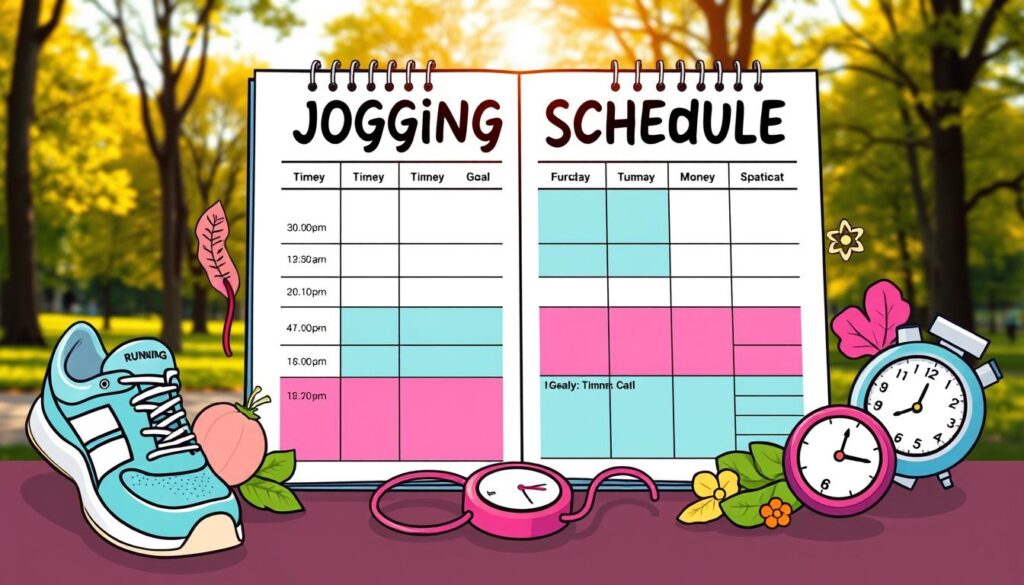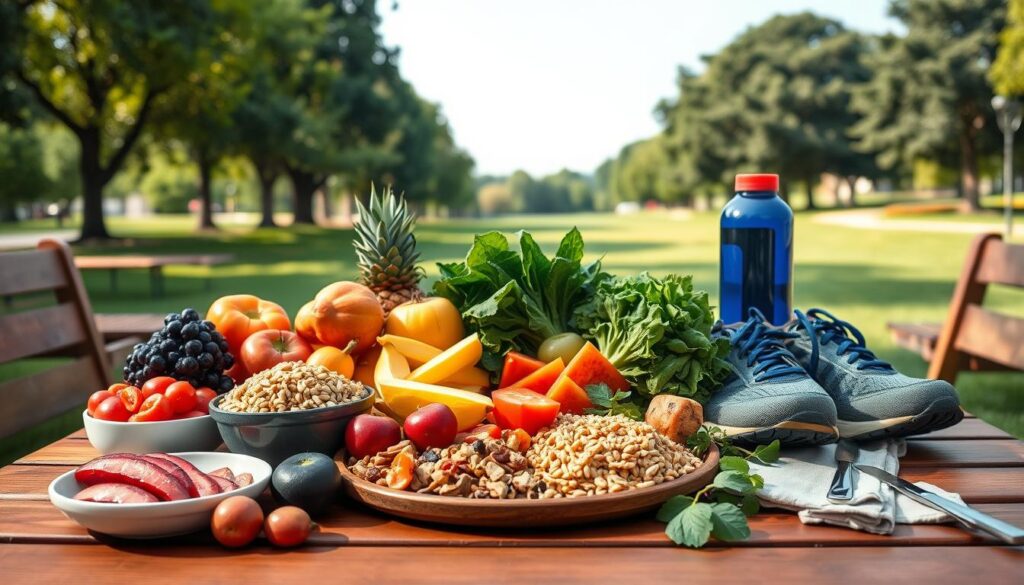Jogging is a top choice for losing weight and burning belly fat. Studies show it works well, even without changing what you eat. This is because jogging uses a lot of calories, making it great for those who want to lose weight fast.
Belly fat, or visceral fat, comes from many things like genes, hormones, and stress. Being active and eating right can help fight this. Jogging regularly can help you win the battle against belly fat.
Key Takeaways
- Jogging is a highly effective exercise for overall fat loss, including stubborn belly fat.
- Running burns significantly more calories than many other forms of cardio, making it a time-efficient weight loss strategy.
- Factors like genetics, hormones, stress, and lifestyle choices can all contribute to the accumulation of belly fat.
- Incorporating regular jogging into your routine can help combat these factors and promote a healthier body composition.
- Consistent jogging, combined with a balanced diet, can lead to sustainable weight loss and a reduction in belly fat.
Understanding Belly Fat and Its Impact on Health
Belly fat is a big health worry. It can harm your health a lot. There are two kinds of belly fat: visceral and subcutaneous.
Types of Belly Fat: Visceral vs Subcutaneous
Visceral fat is deep and wraps around your organs. It’s bad because it raises your risk of serious health problems. Subcutaneous fat is the fat you can pinch under your skin.
Health Risks Associated with Excess Belly Fat
Too much belly fat, especially visceral, is very risky. It can lead to heart attack, cardiovascular disease, stroke, type 2 diabetes, breast cancer, colorectal cancer, and Alzheimer’s disease. It’s important to get rid of belly fat to stay healthy.
Common Causes of Belly Fat Accumulation
Many things can make belly fat grow. A bad diet, not moving enough, stress, hormonal changes, and genes are some. Eating too much junk and not exercising can make belly fat worse. Stress and not moving enough also add to belly fat.
“For weight management, staying in the optimal ‘fat-burning’ moderate intensity activity zone which is roughly 60-70% of your maximum heart rate is recommended.”
| Factors | Impact on Belly Fat |
|---|---|
| Poor Diet | Increased accumulation of belly fat |
| Lack of Exercise | Promotion of belly fat development |
| Stress | Increased cortisol levels leading to belly fat gain |
| Hormonal Changes | Disruption of hormonal balance and potential belly fat accumulation |
| Genetics | Predisposition to storing fat in the abdominal region |
Does Jogging Burn Belly Fat?
Jogging is great for losing belly fat. It helps by burning more calories than you eat. This is key for weight loss.
High-intensity running also helps by making you feel full. It lowers hunger hormones and boosts fullness hormones.
Studies prove jogging can cut belly fat. It targets the bad fat around your organs. The American Council on Exercise says jog for 30 to 60 minutes, four times a week, for best results.
“A person weighing 70 kilograms can burn 563 calories in an hour by jogging in place with high intensity.”
To get the most out of jogging, keep your form right. Stand tall, feet apart, and look ahead. Use your arms to burn more calories.
Being consistent is important for jogging for belly fat reduction and running for fat loss. Make jogging a regular part of your week. Eat well too, for the best results in losing belly fat.
The Science Behind Fat Burning Through Running
When you jog, your body uses glycogen and fat for energy. Running when you haven’t eaten can make your body burn more fat. But, how much fat you burn depends on many things like how hard you run and your diet.
How Your Body Burns Fat During Exercise
Running hard can make your body burn calories for up to 48 hours after. This is called the “afterburn effect.” It means you keep burning fat and calories even after your run is over.
The Role of Metabolism in Fat Loss
Your metabolism is key to burning calories while jogging. To find your metabolism rate, use your age, height, and weight. Then, multiply it by an activity factor to find your daily calorie needs. Try to eat 200 calories less each day to lose fat.
Optimal Fat-Burning Heart Rate Zones
| Heart Rate Zone | Percentage of Maximum Heart Rate | Fat-Burning Benefits |
|---|---|---|
| Moderate | 65-85% | Optimal for fat burning zones for jogging |
| High-Intensity | 85-95% | Increased calorie burn, “afterburn” effect |
To burn more fat, run at a moderate pace. This means your heart rate should be between 65-85% of your max. This way, your body uses both fat and carbs for energy.
Benefits of Jogging for Weight Loss
Jogging is great for losing weight. It’s an aerobic exercise that burns lots of calories. This makes it a top choice for those trying to lose weight.
Jogging also boosts your metabolism. This means you burn more calories all day, not just when you’re jogging.
Plus, jogging helps control your appetite. It makes you feel full and less hungry. This makes it easier to eat the right amount of food.
Jogging is also good for your mind. It improves your mood and reduces stress. This can help you eat less when you’re stressed or upset.
Jogging is easy and cheap. You can do it almost anywhere. It helps you burn calories, boost your metabolism, and stay healthy. So, jogging is a great way to lose weight and feel better.
“The beauty of jogging is that it’s a simple, yet highly effective way to improve your physical and mental well-being. By incorporating it into your routine, you’re taking a significant step towards a healthier, happier you.”
Essential Running Techniques for Maximum Fat Burn
To get the most out of jogging for fat burn, learn the right techniques. Focus on form, posture, breathing, and pacing. These help a lot in losing weight.
Proper Running Form and Posture
Keep your posture straight with relaxed shoulders and a slight lean forward. Don’t hunch over. It limits your breathing and hurts your back and neck. Use your core to stay balanced and stable.
Breathing Techniques While Running
Good breathing is key for better running and fat burn. Take deep belly breaths, inhaling through your nose and exhaling through your mouth. Try to breathe in sync with your steps.
Pacing Strategies for Fat Loss
Try interval training for fat loss. Alternate between fast runs and rest. Do knee-lift runs for 5-10 minutes to work your core. Slowly increase your runs to burn more calories, but don’t go too fast to avoid injuries.
Learning these running techniques will help you burn fat and reach your weight loss goals.
Creating an Effective Jogging Schedule
Creating a good jogging schedule is key to losing weight. It doesn’t matter if you’re new or have been running for a while. A plan that fits you can help burn belly fat.
Beginners should start with 3-4 runs a week, each lasting 30-45 minutes. As you get fitter, add more runs to 5 days a week. This slow increase helps your body adjust and avoids injuries.
Try mixing short, fast runs with longer, steady ones for better fat loss. Health experts say to do 1.25-2.5 hours of hard exercise weekly. Consistency is key – it’s better to run often than to do long runs sometimes.
Don’t forget to take rest days to avoid getting too tired or hurt. Pay attention to how your body feels and change your plan if needed. With hard work and patience, your jogging schedule for weight loss and running routine for beginners will be a big part of your healthy life.

High-Intensity Interval Training (HIIT) with Jogging
HIIT is a powerful way to burn belly fat! Mixing HIIT with jogging is a big change for losing weight, especially around your belly. HIIT workouts can cut down fat time in half compared to steady cardio, a study in the Journal of Diabetes Research shows.
Sample HIIT Running Workouts
Try these HIIT running workouts for the best fat-burning:
- Sprint Interval Training (SIT): Do 4-6 sets of 30-second sprints, then rest for 4 minutes.
- 30 Seconds On, 30 Seconds Off: Run hard for 30 seconds, then rest for 30 seconds. Do this 5 times.
- Longer Intervals: Run at 85-95% of your max heart rate for 4 minutes, then rest for 10 minutes. Repeat 4 times.
Benefits of HIIT for Belly Fat Loss
HIIT is better at burning fat than steady-state running. It keeps burning calories for 24 to 48 hours after, helping with HIIT running for fat loss and interval training for belly fat. It also helps keep muscle while losing fat, keeping you toned and lean.
“HIIT workouts are shorter than traditional exercises, great for busy people.”
But, HIIT can be risky for some health issues. Always talk to your doctor before starting HIIT. With care and advice, HIIT running can help you reach your fitness goals.
Nutrition Tips to Support Your Jogging Routine
Eating right is key for jogging and losing fat. Eat foods that give you energy and help you recover. Focus on lean proteins, complex carbs, and healthy fats.
Begin with a protein-rich breakfast. Try eggs, Greek yogurt, or a smoothie with protein powder. This keeps you full and stops you from eating junk.
- Eat 60-70% of your calories from complex carbs like whole grains, fruits, and veggies. They give you energy for running.
- Choose lean proteins like chicken, fish, tofu, or beans. They help your muscles recover and keep you lean.
- Add healthy fats from avocados, nuts, seeds, and olive oil. They make you feel full and are good for you.
Drinking water is also very important. It helps you run better and lose weight. Drink water before, during, and after your runs.
| Nutrient | Optimal Intake for Runners | Benefits |
|---|---|---|
| Carbohydrates | 60-70% of total calories | Provides sustained energy for runs |
| Protein | 15-20% of total calories | Supports muscle recovery and maintenance |
| Healthy Fats | 15-20% of total calories | Promotes satiety and overall health |
By matching your diet for runners and nutrition for fat loss, you can fuel your body. This supports your jogging and helps you lose weight. Always talk to a dietitian or doctor for advice on what you should eat.

Common Mistakes to Avoid When Running for Fat Loss
Starting a running journey to lose weight? Watch out for these common mistakes. One big running mistake is overtraining. It can cause burnout, injury, and even weight gain.
It’s important to slowly increase how hard and long you run. Let your body recover fully.
Don’t skip strength training. Adding resistance exercises to your jogging can build muscle. It also boosts your metabolism and fat burning.
Not changing your running routes and how hard you run can also be a problem. Your body gets used to the same thing.
Good nutrition is key for losing fat. Thinking you burn too many calories or eating too little can lead to bad eating. This can slow down your metabolism.
Eat a balanced diet, drink plenty of water, and avoid fad diets. They can hurt your weight loss goals in the long run.


A Life-Changing Experience with This Weight Loss Supplement (Nagano Tonic)
I’ve always struggled with finding a weight loss solution that actually works for me. Like many, I’ve tried numerous diets, exercise routines, and supplements over the years—some worked for a short time, but nothing ever gave me long-term results. That was until I decided to try the weight loss supplement I found : Link to the Supplement.
From the moment I started using it, I noticed a difference. Not only did I feel more energized, but my cravings also became more manageable. The best part? I started seeing results much quicker than I anticipated! Over the course of just a few weeks, I noticed a significant reduction in belly fat and overall weight loss that I hadn’t been able to achieve before.
What makes this supplement stand out from all the others I’ve tried is how it supports me in my daily routine without any jitters or energy crashes. I’m able to stay focused and motivated, which has made it easier to stay on track with my diet and exercise plan.
This product truly exceeded my expectations, and I feel more confident and healthier than ever before. If you’re struggling with your weight loss journey like I was, I highly recommend giving this supplement a try. It’s been a game-changer for me, and I’m sure it can work wonders for you too!
Contant Them on email .. tonicnagano50@gmail.com